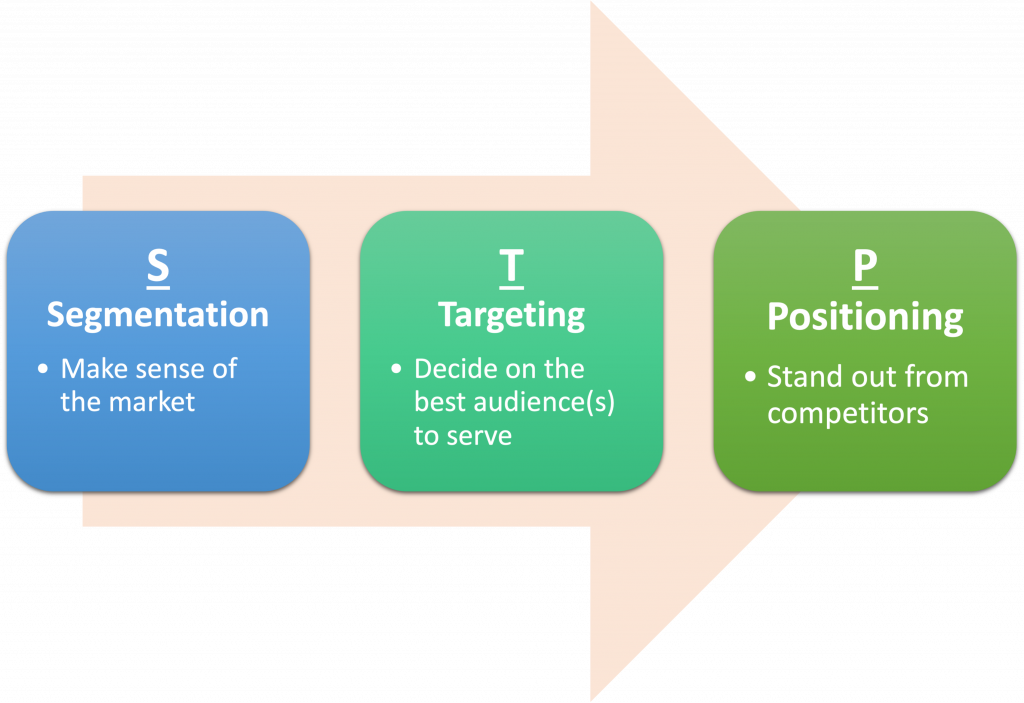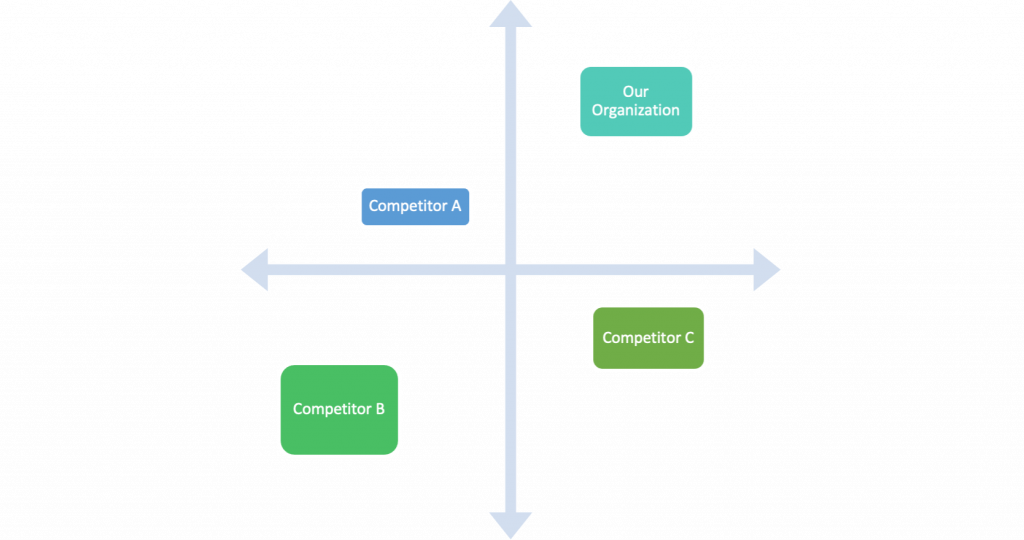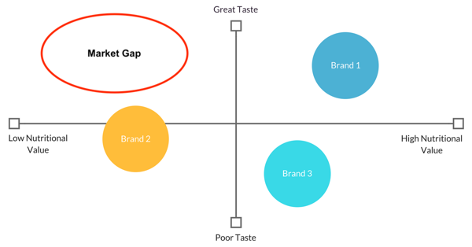5 Target Market and Audiences
Learning Objectives
By the end of this chapter, you should be able to:
- Define segmentation, targeting, and positioning (STP)
- Explain the STP Framework
Introduction to the STP Framework
One of the quintessential questions repeatedly asked in marketing is:
- What is your target market and more specifically, who is your target audience / customer?
For many of you, these may seem like a very easy questions to answer. But, let’s ask a few more detailed questions:
- Are there any differences between your potential customers and existing customers?
- Do all your existing customers behave the same?
- What patterns do you see within your existing customers, e.g., do you have “complainers”, “repeat users”, “loyalists”, “early adopters”, etc.?
- What patterns do you see with potential customers (also referred to as prospective customers or prospects)?
As you begin to look closely at your customers, you may start noticing that your customers vary quite a bit.
To better understand your customers, let’s review a core marketing model that can help you define and scope out your target market and audiences, namely the STP framework. The STP process is a frequently used framework for today’s digital marketers because of its customer-centric approach. The letters STP refer to customer segmentation, targeting, and positioning. In this chapter, we’ll review each one of these areas in detail. Using this framework, you will be able to deliver personalized and relevant digital marketing strategies that improve customers’ experiences, as well as remain competitive.
Definitions of Segmentation, Targeting, and Positioning
Segmentation can be defined as:
Splitting up a market or audience into smaller-sized groups (segments) that have similar attributes, behaviours, or product / service needs.
Targeting (or target audience selection) refers to:
Identifying an appropriate market or audience segment (or segments) to focus an organization’s marketing efforts on.
Positioning (which is often described as product positioning) is:
Communicating and differentiating a brand’s key benefits and features, relative to the competition, to influence the target audience’s perception of the brand.
The STP Process
The steps in STP are commonly described as a process, with segmentation being carried out first, followed by defining one or more target audience(s), then positioning your product or service appropriately, and finally, identifying the optimal marketing mix for each segment (see image below). A marketing mix is the set of marketing strategies or tactics that an organization uses to sell products or services to its target audience.

While the letters STP represent three important concepts in this framework, they are essentially one integrated process. They build on each other to deliver a high-level strategy, which determines your marketing mix. The objective of the STP process is to guide each organization to deliver the best experience for its targeted audience(s).
For more information on the STP framework and the marketing mix, please watch the following videos:
The diagram below shows how plans can flow from market segmentation to audience selection to product or service positioning.
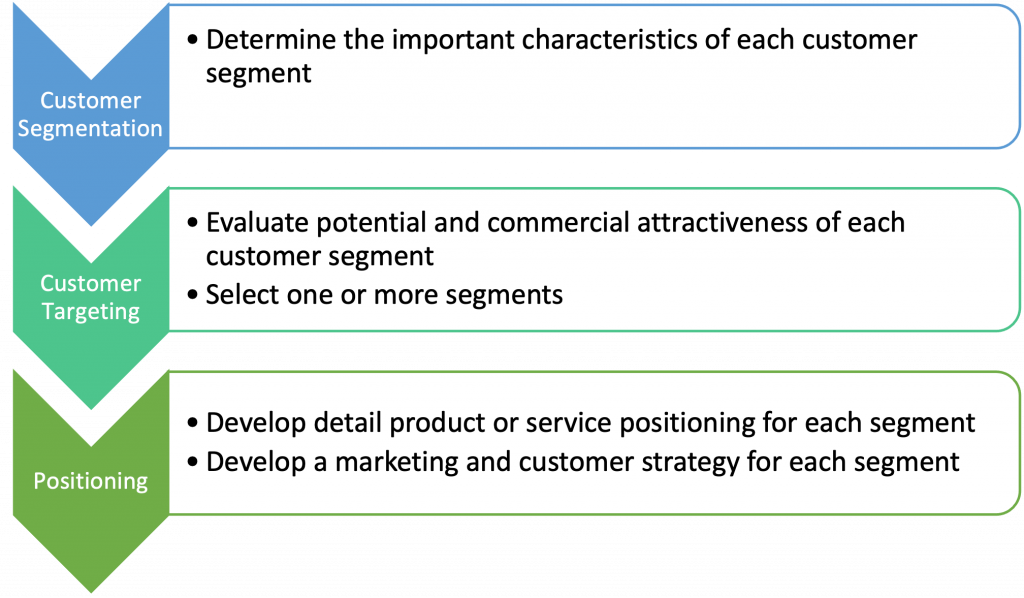
In marketing, the STP components and processes answer several essential organizational questions, such as:
- Where do we compete?
This is addressed via your market and audience segmentation and your choice of the target audience(s).
- How to we compete?
This is answered by your positioning strategy as well as the execution of a supportive marketing and audience strategy, i.e., your marketing mix.
In essence, STP focuses on commercial effectiveness, selecting the most valuable segments for an organization and then developing a marketing strategy and product positioning strategy for each segment.
Segmentation
 Many of you have probably heard about the Pareto principle (also called the 80/20 rule). The Pareto principle states that for many outcomes roughly 80% of consequences come from 20% of the causes. For example, maybe 80% of your sales come from 20% of your customers. However, we are finding that marketers today find themselves in a post-Pareto world, where the causes and effects of consumer actions are driven by an even smaller, elite minority – meaning 80% of your revenues may come from only 5% of your customers. As a result, audience segmentation is critical in identifying those segments that are truly supporting your organizational goals and objectives.
Many of you have probably heard about the Pareto principle (also called the 80/20 rule). The Pareto principle states that for many outcomes roughly 80% of consequences come from 20% of the causes. For example, maybe 80% of your sales come from 20% of your customers. However, we are finding that marketers today find themselves in a post-Pareto world, where the causes and effects of consumer actions are driven by an even smaller, elite minority – meaning 80% of your revenues may come from only 5% of your customers. As a result, audience segmentation is critical in identifying those segments that are truly supporting your organizational goals and objectives.
With segmentation, you can identify specific customer niches that have particular needs, find new customers in mature markets, and provide even more focused and efficient marketing experiences. The requirements for each segment should be unique, allowing marketers to deliver personalized and relevant experiences instead of one-size-fits-all solutions. This technique has proven to be a lot more effective and can provide a tailored experience for your target audience.
Now, let’s look at how you might segment your existing markets or audience:
- Demographics
Historically, demographics have been the most popular way to segment audiences. This type of segmentation typically breaks down your market or audiences using any combination of the following:- age,
- gender,
- income,
- education,
- ethnicity,
- marital status,
- education,
- household (or business) size,
- length of residence,
- type of residence, or
- even profession/occupation.
While this information is a great starting point, do be careful about lumping people together based solely on the above. As we are seeing, there is a wide range of diversity in our audiences; just because someone is a specific age or gender does not mean that they belong to a specific segment. For optimal segmentation, it is best to combine several of these segmentation options to create a fuller and more comprehensive profile of your target audiences.
- Geographic
Using geographic data, marketers can drill down by country, region, area, neighbourhood, metropolitan or rural location, population density or even climate.
- Psychographics
Psychographics represent some of the most important criteria marketers can reference in identifying ideal target audiences. Psychographics refers to ‘personality and emotions’, based on behaviours linked to purchase or engagement choices. Some common psychographics include:
-
- attitudes,
- lifestyle,
- hobbies,
- risk profiles, e.g., risk-averse or risk-seeking,
- personality and leadership traits,
- life stages,
- religious, political, nationalistic, or cultural beliefs and values
- publications or books read,
- websites visited,
- recreational pursuits and/or destinations, and
- entertainment (movies, TV, or music) preferences.
While demographics explain ‘who’ your audience is, psychographics inform you ‘why’ your audience buys or engages.
- Behavioural
Behavioural attributes refer to the:
-
- nature of the purchase or engagement,
- brand loyalty,
- usage level,
- benefits sought,
- distribution channels used, and
- reaction to marketing factors.
For example, in a business-to-business (B2B) environment, the benefits sought might be: ‘how soon can it be delivered?’ In this case, segments might include a ‘last minute’ segment and a ‘planning in advance’ segment.
One helpful segmentation tool is the PRIZM segmentation tool (https://prizm.environicsanalytics.com/). This online resource categorizes people into 66 different segments tied to postal codes. The PRIZM approach is based on the idea that “birds of a feather flock together,” suggesting that people tend to live near others similar to them. People who live in the same neighbourhood (geographic) often have similar demographic characteristics (income, age, family life cycle), have similar lifestyles and opinions (psychographics), and behave similarly (behavioural) (see the PRiZM screenshot below for the S4N 0W6 postal code near Regina, Saskatchewan, Canada).
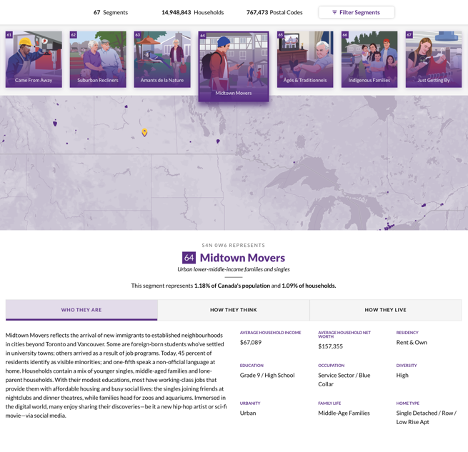
Go to PRIZM and type in your postal code. Does the description accurately describe your neighbourhood?
If your organization wants more detailed segmentation information, you can explore PRIZM’s more advanced, paid version called DELTA (https://environicsanalytics.com/en-ca/data/segmentation/delta). Please note that there are other segmentation tools, which cover different geographic areas and use slightly different approaches. For example, if you are in the US, you can use zip codes with PRIZM, Claritas360 or Tapestry.
Tapestry profiles summarize the common lifestyle traits for the neighbourhood, and also include several key marketing factors about the group such as spending trends and shopping preferences. If you are looking at more international audiences, you can check out Personicx, developed by Acxiom, which identifies 55 clusters based on a combination of behavioural, lifestyle, and demographic factors.
By referencing similar data, marketers should be able to clearly identify the key behaviours and characteristics of not only existing audiences, but also those of future audiences.
Criteria for Effective Segmentation
When evaluating the potential and commercial attractiveness of target segments, do keep in mind several of the following considerations:
- Identifiable: Each segment must be easily identifiable and unique.
- Substantial: The market must be large enough to justify segmenting. If the market is already small, segmenting it will only make it smaller.
- Measurable: Measurable differences must exist between segments.
- Profitable: Anticipated profits should exceed the costs of additional marketing plans, resources, and other activities.
- Accessible: Each segment should be accessible to your team and able to receive your marketing messages.
- Unique: Different segments should require different benefits.
- Responsive: Each segment should be willing to engage with and respond to your marketing mix.
Once you’ve decided on your target segments / audiences, it’s time to look at targeting.
Targeting
 After the segmentation process is complete, the next step is targeting, which involves choosing a segment or segments to target and engage with. There are four common targeting strategies that marketers can implement:
After the segmentation process is complete, the next step is targeting, which involves choosing a segment or segments to target and engage with. There are four common targeting strategies that marketers can implement:
- Mass / undifferentiated
- Segmented / differentiated / multi-segmented
- Niche / concentrated
- Micromarketing
The table below describes each of these strategies and provides an example:
Targeting Strategies
| Strategy | Description | Example |
| Mass / Undifferentiated | Sending the same marketing messages to everyone | Promoting your product or service by placing ads on widely read websites |
| Segmented / Differentiated / Multi-segment | Designing more than one marketing message / activity, with each communicating different benefits | Targeting multiple audience segments by communicating unique, personalized marketing messages about your product benefits in multiple marketing channels |
| Niche / Concentrated | Designing a marketing activity that communicates the benefits desired by a single specific segment | Promoting your product or service by targeting specific buyers via specific marketing channels, e.g, Whole Foods |
| Micromarketing | Design marketing messages / activities targeted at individual audience members or localized microsegments | Promoting your product or services to individual customers using individualized or localized offers, e.g., Groupon |
Mass / Undifferentiated Targeting
An undifferentiated targeting strategy is used when an organization decides to communicate the benefits of its product or service by sending the same marketing message to everyone. For an undifferentiated strategy to be successful, the organization’s product or service must be readily available and affordable and must provide the same benefits to all consumers. The success of mass or undifferentiated targeting depends on whether it is possible to reach enough customers, through mass-marketing techniques and one universal product offer, to keep customers interested in the product and make the strategy worthwhile. While mass-targeting tactics tend to be costly because they operate on a large scale, this approach can yield efficiencies and cost savings for organizations because it requires the marketing team to execute only one product offer and marketing mix. Many mass-targeted items are considered staple or “commodity” items. People buy new ones when the old ones wear out or are used up, and mass-targeted brand loyalty may be the primary driver when customers decide which replacement product to purchase.
Segmented / Differentiated Targeting
A differentiated targeting strategy is one in which the organization decides to provide separate offerings to different market segment that it targets. It is also sometimes called multi-segment targeting. Each segment is targeted in a particular way, as the organization provides unique benefits to different segments. The goal is to help the organization increase sales and market share across each segment it targets. When successful, differentiated targeting can create a very strong, entrenched market presence that is difficult for competitors to displace. However, differentiated targeting is also very expensive. It carries higher costs for the organization because it requires the development of unique products / services and marketing to fit each target segment. One example is Oreo cookie’s differentiated targeting strategy for the Chinese market. Consumers there can enjoy Oreos with ice cream flavours such as green-tea ice cream, raspberry-blueberry, mango-orange, and grape-peach. All of these Oreo formulations have been heavily market tested and are based on the unique preferences of Chinese consumers.
Niche / Concentrated Targeting
Niche targeting (also called concentrated targeting) is a strategy that targets only one or a few well defined and specific segments of the target market. The goal is to achieve high penetration among the narrowly defined target segments. An organization that adopts a niche targeting strategy gains an advantage by focusing all its efforts on only one or a small handful of segments. When done well, this approach can provide a significant advantage over other organizations that don’t have the same focus.
Niche targeting is particularly effective for smaller organizations with limited resources since it does not require mass production, mass distribution, or mass advertising. When an organization is highly successful in a desirable “niche” market, it can be very profitable. That said, the primary disadvantage of niche targeting is that organizations can become heavily reliant and dependent on these narrow markets. And if something changes and demand or interest drops, the organization has little cushion from the financial impact and therefore, is always somewhat at-risk. To protect themselves against this type of risk, organizations should target multiple niche segments, if possible.
Micromarketing
Micromarketing is a targeting strategy that focuses even more narrowly than niche targeting. It caters to the needs of individuals (“individual marketing”) or very small segments in a targeted geography (“local marketing”). Micromaketing can be very powerful by giving customers exactly what they want, when they want it. However, to achieve large-scale success with this approach, organizations must figure out how to meet highly individualized needs efficiently and profitably.
Now, let’s look at positioning.
Positioning
 Once again, positioning relates to the target audience’s perception of the product or service’s key benefits and features, relative to the competition. To better understand how your target audience sees you relative to your competitors, marketers will often use a product positioning map (sometimes also called a perceptual map) to identify market opportunities, gaps, and even crowded markets to avoid. A product positioning map is a visual chart where organizations visually display the position of their products or services against their competition (see chart below).
Once again, positioning relates to the target audience’s perception of the product or service’s key benefits and features, relative to the competition. To better understand how your target audience sees you relative to your competitors, marketers will often use a product positioning map (sometimes also called a perceptual map) to identify market opportunities, gaps, and even crowded markets to avoid. A product positioning map is a visual chart where organizations visually display the position of their products or services against their competition (see chart below).
To create a positioning map, marketers need to decide which product or service characteristics to compare, i.e., the titles of the x- and y-axes. There are five common strategies upon which organizations often base their positioning:
- Product / service characteristics and attributes
Using product / service features or benefits associates your brand with certain characteristics that are beneficial to your target audience.
- Price
Usually, with a pricing positioning strategy, a brand aims to be the cheapest or one of the cheapest in the market, and value becomes their position.
- Quality or luxury
Positioning a product based on its high quality or ‘luxury’ is different from positioning based on price. While prices may signal a specific level of quality, many organizations promoting luxury items do not promote their prices. Rather, they focus on the quality of the customer experience. So, for clarity, we have separated the two.
- Product use or application
Associating your product with a particular use is another way to position your brand in the market. Many mobile apps use this type of positioning strategy, e.g., fitness apps target individuals who want to monitor and improve their fitness; whereas game apps focus on people looking for entertainment.
- Competition
Competitor-based positioning focuses on using the competition as a reference point for differentiation.
The following perceptual map compares brands based on taste and nutritional value:
While we can see a market gap in the “Great taste / low nutritional value” area, marketers will still need to ask whether positioning in all areas makes sense? For example, why would customers buy something that tastes great with low nutritional value, when Brand 1 offers great taste AND higher nutritional value. In some cases, market gaps may exist because they don’t make sense to pursue. That said, in the above graph, there may still be a positioning opportunity to provide a product offering great taste and even higher nutritional value than Brand 1.
(Please note that great marketers will often create multiple perceptual maps to understand audience preferences across multiple variables and to get a more wholistic view of the market and market gaps.)
Key Takeaways
- The core elements of the STP framework are segmentation, targeting and positioning
- STP is an excellent framework to identify and define your target market, audiences, and how you plan to differentiate your products or services from the competition.
Exercises
Here is a segmentation exercise from Great Ideas for Teaching Marketing:
Segmentation Rules
- You need to create three segments each time only.
- You must have at least two consumers in each segment.
- The consumers in the segment must have one or more things in common (based upon their characteristics).
Create Three Segments for These Consumers
| Person | Age | Where They Live | Marital Status | Social Class | Loyalty to Brands | Price Sensitivity | Lifestyle | Benefit Sought |
| 1 | 19 | Rural | Single | Lower | Low | Medium | Family | Best value |
| 2 | 47 | Suburbs | Married | Lower | Low | High | Social | Best price |
| 3 | 66 | Suburbs | Married | Middle | Low | High | Social | Best price |
| 4 | 23 | Rural | Married + children | Middle | Low | High | Family | Best price |
| 5 | 64 | Rural | Married + children | Lower | Medium | Medium | Family | Best value |
| 6 | 25 | City | Single | Middle | Medium | Medium | Sporty | Best quality |
| 7 | 35 | Suburbs | Single | Middle | Medium | Medium | Travel | Best value |
| 8 | 50 | Suburbs | Married + children | Upper | Medium | High | Family | Best price |
| 9 | 36 | Suburbs | Married + children | Middle | High | Low | Sporty | Best quality |
| 10 | 50 | City | Married | Middle | High | Medium | Travel | Best quality |
| 11 | 53 | Suburbs | Single | Upper | High | Low | Travel | Best quality |
| 12 | 70 | City | Married | Upper | High | Low | Sporty | Best value |
Discussion Questions
- There are eight characteristics for each consumer. Two are psychographic/lifestyle variables, three are behavioural variables, and three are geographic/demographic variables. Start by identifying which variables are in each of these categories.
- Identify three market segments, using:
- A. Psychographic/lifestyle variables as the segmentation base/s
- B. Behavioural variables as the segmentation base/s
- C. Geographic and/or demographic variables as the segmentation base/s
- For each approach, how would you define each of your segments? That is, create a brief segment profile for each segment. (Note: You should have nine segments – 3 X the three approaches.)
- Choose the segmentation approach that you think works best for these consumers (this market). That is, the best approach in this market is… psychographic, behavioural, OR geographic/demographic? Why?

